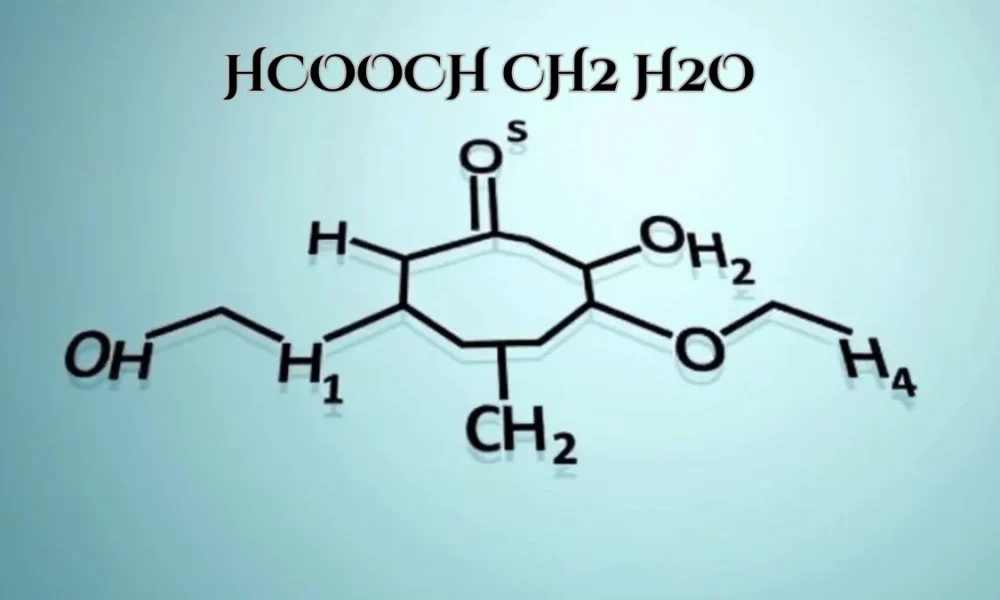The Alchemy of HCOOCH CH2 H2O,Welcome to a fascinating journey into the world of chemistry, where molecules dance and reactions unfold in surprising ways! Today, we’re diving deep into a compound that might not get as much spotlight as it deserves—methyl formate (HCOOCH₃). This intriguing ester is more than just a chemical formula; it’s a gateway to understanding essential processes, such as hydrolysis. Ever wondered how this seemingly simple molecule interacts with water? Or why are its transformations important in both nature and industry? Join us as we explore the captivating chemistry behind methyl formate and discover how its hydrolysis can reveal insights into everything from food flavor profiles to innovative solutions for sustainable energy. Get ready to unlock the bonds that connect science and everyday life!
Introduction to Methyl Formate and Its Formula
Methyl formate, with its chemical formula HCOOCH2H2O, is a fascinating compound that plays a significant role in various chemical processes. Known for its distinctive characteristics and versatility, this ester offers much more than meets the eye. As we delve deeper into the world of methyl formate and explore its hydrolysis, you’ll discover how water interacts with this intriguing molecule. The chemistry behind these reactions not only showcases nature’s complexity but also highlights the importance of understanding such compounds in both scientific research and industrial applications. Get ready to uncover the secrets of HCOOCH2H2O!
Understanding Hydrolysis and Its Role in Chemical Reactions
Hydrolysis is a fascinating chemical process. It involves the reaction of water with another compound, breaking it down into simpler substances. This transformation is crucial in many biological and industrial contexts.
During hydrolysis, water molecules interact with compounds, facilitating the cleavage of chemical bonds. By adding a molecule of water to a substance like methyl formate (HCOOCH CH2 H2O), you can create new products. This reaction plays a crucial role in various fields, including biochemistry and environmental science. For instance, enzymes often catalyze hydrolysis reactions within living organisms.
In industry, understanding hydrolysis helps improve processes for synthesizing chemicals or degrading pollutants. The versatility of this reaction underscores its significance in both natural and technological contexts. Hydrolysis not only aids in the decomposition of complex molecules but also facilitates the release of nutrients from organic matter—supporting ecosystems worldwide.
The Chemical Components of HCOOCH CH2 H2O: Methyl Formate and Water
Methyl formate, represented by the formula HCOOCH CH2 H2O, is an ester derived from methanol and formic acid. Its structure showcases a carbon atom bonded to both a methyl group and a formyl group, making it versatile in various chemical reactions.
When water (H2O) enters the scene, it plays an essential role. Water molecules are polar, meaning they have distinct positive and negative ends. This polarity allows them to interact effectively with different substances.
In the case of methyl formate, water can participate in the hydrolysis process. During this process, water breaks down methyl formate into its constituent parts: methanol and formic acid.
This reaction illustrates how two simple components—methyl formate and water—can combine to form more complex compounds through interaction. Understanding these interactions provides insight into broader chemical processes that occur in both nature and industry.
How Does Hydrolysis of Methyl Formate Occur?
The hydrolysis of methyl formate involves a reaction with water, breaking down the compound into its constituent parts. This process is typically catalyzed by an acid or base, which enhances the rate at which the reaction occurs.
When methyl formate (HCOOCH3) interacts with water (H2O), it forms methanol and formic acid. The nucleophilic attack from water on the carbonyl carbon initiates this transformation. During this interaction, two key bonds are altered. The bond between carbon and oxygen in methyl formate is cleaved while new bonds are formed to create methanol and formic acid.
Temperature and pH levels can also influence the rate of hydrolysis. Higher temperatures often accelerate chemical reactions, leading to quicker breakdowns of compounds like methyl formate.
Applications of Hydrolysis and Methyl Formate in Industry
Methyl formate, represented by the formula HCOOCH2, plays a significant role in various industrial applications. Its ability to undergo hydrolysis makes it invaluable in chemical synthesis and production processes.
In the pharmaceutical industry, methyl formate is used as an intermediate in the production of active ingredients. This compound’s versatility enables chemists to tailor reactions that result in complex molecules. Moreover, methyl formate finds its place as a solvent in coatings and adhesives. Its favorable properties contribute to effective formulations without compromising environmental standards.
The agricultural sector also benefits from this compound. Methyl formate serves as a precursor for pesticides and herbicides, enhancing crop protection while minimizing ecological impact. Diverse applications showcase how hydrolysis of methyl formate can facilitate innovation across multiple industries, driving sustainable practices forward.
Environmental Impact of Methyl Formate and Hydrolysis
Methyl formate, represented by the chemical formula HCOOCH2, is not just a fascinating compound but also one that has environmental implications. Its use as an industrial solvent and in manufacturing processes raises questions about its impact on ecosystems.
When methyl formate undergoes hydrolysis, it produces methanol and formic acid. This reaction can be beneficial in some contexts but may pose risks if released into water sources. Formic acid, while naturally occurring, can contribute to acidity levels in aquatic environments.
Additionally, methyl formate has a relatively low ozone depletion potential compared to other solvents. However, improper disposal or uncontrolled releases can still lead to air pollution issues.
Understanding how methyl formate interacts with water during hydrolysis enables scientists to develop more effective management strategies for minimizing the negative effects on our planet’s health. The delicate balance between utilization and preservation requires ongoing research and awareness.
Conclusion
Studying chemical reactions, such as hydrolysis, is crucial for deepening our understanding of complex compounds. The process allows scientists to explore the behavior and interactions of substances at a molecular level.
Hydrolysis, particularly in the case of methyl formate, demonstrates how simple elements combine and react under specific conditions. This knowledge can lead to advancements in various fields, including pharmaceuticals, agriculture, and environmental science.
By examining compounds such as HCOOCH2CH2H2O, researchers gain insights that contribute to innovation and safety in industrial applications. Understanding these processes not only enriches scientific knowledge but also helps us make informed decisions regarding chemical usage and its potential impacts on our environment.
As we continue to investigate these intricate relationships between chemicals, the significance of this research becomes increasingly evident. It lays a foundation for future discoveries that could transform industries or address pressing global challenges.

